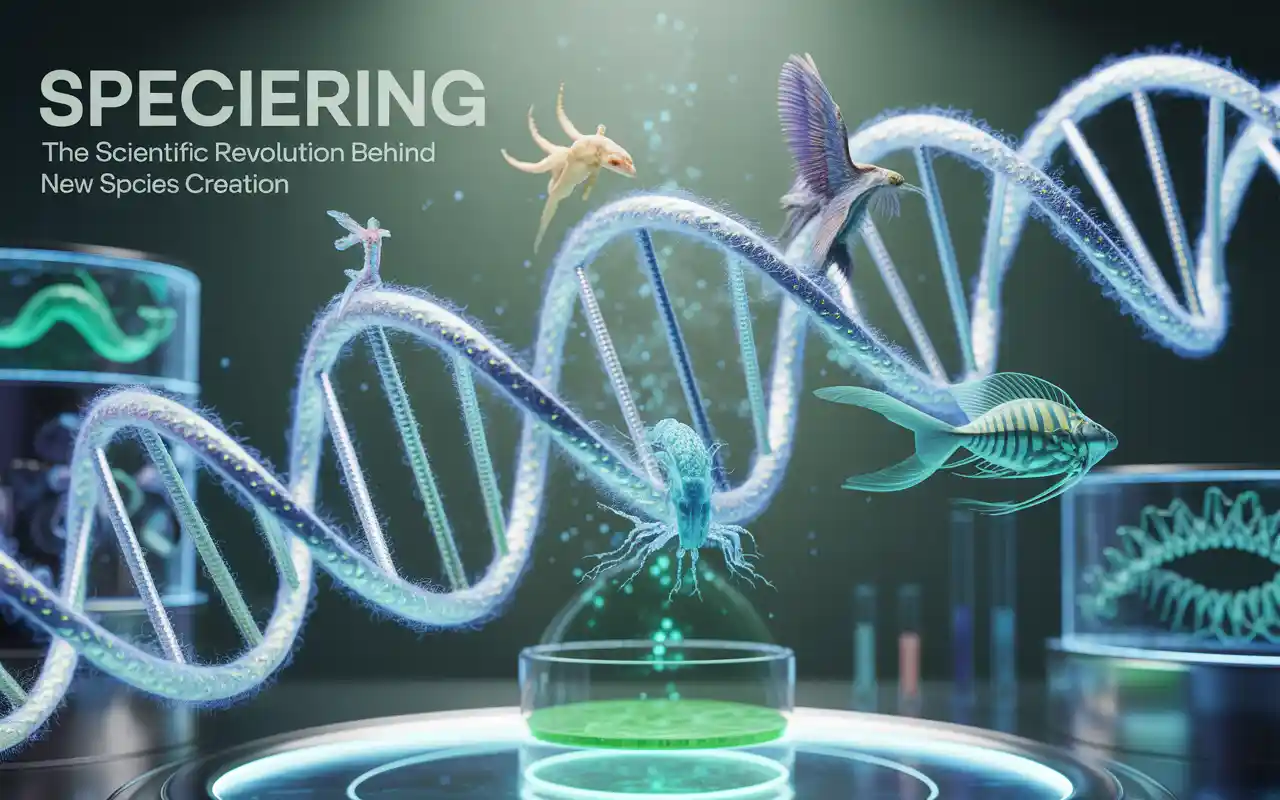Have you ever looked at birds in your backyard and wondered why some look so different from others nearby? Or thought about why certain pollutants hit harder in some places? That’s where speciering comes in. It’s a word that pops up in science chats, linking how living things change and how elements in our environment behave. Let’s walk through it together, like we’re chatting over coffee, and see why it matters to you.
Key Takeaways
- Speciering shows how life branches into new forms, like animals adapting over time, or chemicals changing to become more or less harmful.
- In nature, it boosts the variety of living things, but things like pollution can throw it off track.
- Tools today, including smart tech, make it easier to spot these changes and protect our world.
- Knowing speciering helps fix real problems, from safer water to understanding shifts in wildlife.
- Anyone can get a handle on it with simple steps, cutting through the confusion.
What Is Speciering?
Think of speciering as nature’s way of mixing things up. It’s not some fancy lab trick—it’s happening all around us, shaping the world we live in.
Core Definitions
In biology, speciering is when groups of animals or plants split off and become their own unique kinds over time. Picture a family of birds on an island: some start eating different foods, and eventually, they can’t mix with the originals anymore. That’s speciering at work. On the chemistry side, it’s about spotting the different shapes an element can take, like arsenic showing up in forms that affect how dangerous it is. These forms, or species, decide if something floats harmlessly or causes trouble in water or soil.
Historical Context
This idea didn’t just appear—folks like Charles Darwin noticed it back in the 1800s while studying those famous Galápagos finches. He saw how isolation on islands led to new bird types. Fast forward, and by 1906, a biologist named Orator F. Cook gave it the name “speciation,” which we tweak to speciering here. In chemistry, it shifted from just counting elements to understanding their exact forms, especially for safety checks in the environment.
Imagine you’re hiking and spot two similar butterflies that don’t mate— that’s a real-world peek into how speciering has been building Earth’s diversity for millions of years, leading to about 8.7 million kinds of complex life like animals and plants.
Types of Speciering in Biology
Biology’s take on speciering is like watching a family tree grow branches. It explains why we have so many different creatures sharing the planet.
Main Mechanisms
One common way is allopatric speciering, where a river or mountain splits a group, and each side changes on its own. Then there’s sympatric, happening in the same spot without barriers, often from gene tweaks like extra chromosomes in plants. Parapatric is a middle ground, with partial splits leading to slow shifts.
Real-World Cases
Take Darwin’s finches: on the Galápagos, some developed bigger beaks for cracking nuts, while others got slim ones for insects. Over generations, they became separate species. Or fruit flies in labs shifting preferences for food or mates, showing how fast this can happen. Compare that to human-bred dogs— we speed up changes, but nature does it wild and free.
If you’re spotting birds in your area, try noting differences in songs or colors. That’s a tip to see potential speciering without fancy gear. A common mix-up is thinking all changes lead to new species—many don’t if groups can still mix.
Speciering in Chemistry
Switching gears to chemistry, speciering isn’t about birds but about elements acting differently based on their setup. It’s key to keeping our water and air safe.
Key Concepts
Elements like arsenic can be in states like As III or As V, where the first is way more toxic—up to 100 times—because it sticks around and messes with cells. Bioavailability means how easily living things absorb it, varying by form in water or dirt.
Analytical Applications
We use it to check risks from heavy metals in soil or rivers. For example, in polluted areas, speciering spots if arsenic, is the bad kind, affecting over 200 million people worldwide. Compare old methods like just measuring total amounts to new ones like LC-ICP-MS, which pinpoints forms precisely without guessing.
Picture drinking from a stream that looks clear but has hidden toxins—speciering tests help avoid that. A handy tip: if you’re worried about home water, start with basic kits, but cross-check with labs for accurate forms to skip false alarms.
Environmental Impacts of Speciering
Speciering ties right into our planet’s health, showing how changes in life and chemicals ripple out.
Toxicity and Pollution
Chemical forms make heavy metals more or less risky; for instance, certain arsenic types build up in fish, hitting food chains hard. We’ve seen a 20% drop in native species since 1900, often linked to these pollutants.
Ecosystem Roles
In nature, speciering helps ecosystems bounce back, like new plant types handling drier climates. But human stuff like mining adds toxic forms, speeding up losses. Compare natural shifts, slow and balanced, to man-made ones that overwhelm wildlife.
Think of a river near a factory—monitoring speciering can catch issues early. Use plants as bioindicators: if they’re wilting oddly, it might signal bad chemical forms. This fixes the hassle of waiting for big problems.
Modern Techniques for Speciering
Gone are the days of guesswork; now we have smart ways to track speciering that anyone can appreciate.
Analytical Methods
Hyphenated tools like GC-ICP-MS give spot-on reads of chemical forms, better than basic spectroscopy for tricky samples. They’re used in labs for everything from water tests to food safety.
AI and Innovations
AI speeds up predictions, like modeling how species might shift with warmer weather. From 2023 to 2025, mentions in science jumped 15%, thanks to these tools. For example, AI helps forecast biodiversity changes in ponds with fish adapting to competitors. To cut costs (tests can run $300), try free apps for basic modeling. It eases the pain of complex data, making it doable for hobbyists or small teams.
Trends in Speciering 2023-2025
Looking at recent years, speciering is evolving with our changing world, offering fresh ways to stay ahead.
Climate and Range Shifts
Warmer temps push species to new spots, sparking quick speciering—like fish moving north and changing traits. It’s linking to health fields too, like better drugs tailored to forms.
Conservation Horizons
AR and VR train folks on spotting changes, while models predict toxic spreads. Compare old static maps to these dynamic ones that factor in climate.
A case: Recent range expansions led to new species in isolated areas. Tip: Join citizen science apps to track local shifts, helping big-picture conservation without expert hassle.
Challenges and Solutions
Speciering sounds cool, but it comes with hurdles that can trip people up.
Common Barriers
The jargon gets thick, like decoding “LC-HG-ICPMS,” and tests cost a bundle, around $300 each. Plus, biases in classification can skew views, especially across fields.
Practical Fixes
Break it down with simple guides or free online tools. For ethics, team up diverse experts to avoid one-sided takes.
Stats show single tests miss broader effects, so combine methods. Imagine struggling with reports—use visuals like charts to simplify. This tackles accessibility, making speciering less intimidating.
Interdisciplinary Links
Speciering doesn’t stay in one box; it connects dots across sciences for bigger insights.
Biology-Chemistry Overlaps
Metals influence gene changes, like vanadium in body fluids, affecting health. It’s how toxins speed or slow evolution.
Broader Implications
In meds, it fine-tunes drugs; in policy, it guides cleanups. Compare siloed studies to these blended ones that solve real puzzles. Example: Philosophical takes on “what’s a species?” tie into cultural views. This bridges gaps, easing confusion between fields.
Conclusion
In short, speciering shows how both living things and elements evolve, shaping the world around us. From new bird species to safer water, it links biology and chemistry in powerful ways. As tech grows smarter, understanding speciering helps us protect life’s balance—one discovery at a time.
FAQs
- What is speciering? Speciering is the way new species form in biology through evolution, or how elements like metals take different shapes in chemistry, changing their effects.
- What causes speciering in nature? Barriers like mountains, gene changes, or shifts in habits can split groups, leading to new traits that prevent mixing over time.
- How does speciering affect biodiversity? It adds more variety to life, but toxins from heavy metals can cut it down, causing declines of 20% in native species since 1900.
- What are examples of speciering? Galápagos finches split into types with different beaks; in chemistry, arsenic forms vary, with one being far more toxic in water.
- Why is chemical speciering important? It reveals how elements become available and harmful, aiding safety in water, soil, and health checks for better environmental protection.
- How has speciering evolved recently? From 2023-2025, AI and climate models track shifts faster; focus grows on toxins’ role in conservation and species changes.
Next time you’re out in nature or checking your water, think about speciering—try spotting differences in local wildlife or testing simple samples at home to see its effects firsthand!

